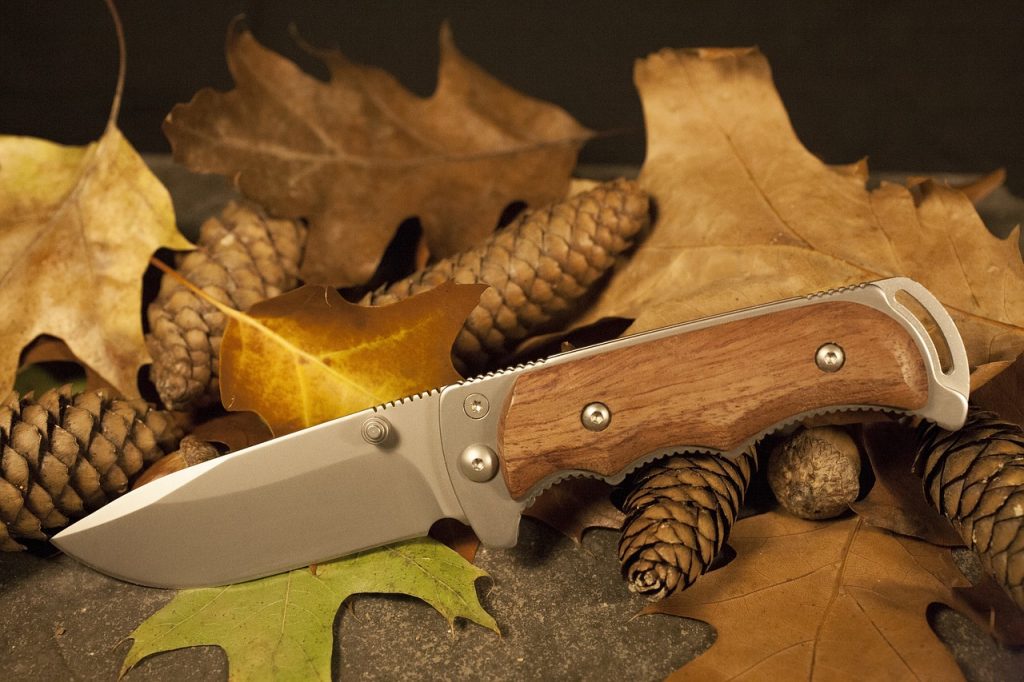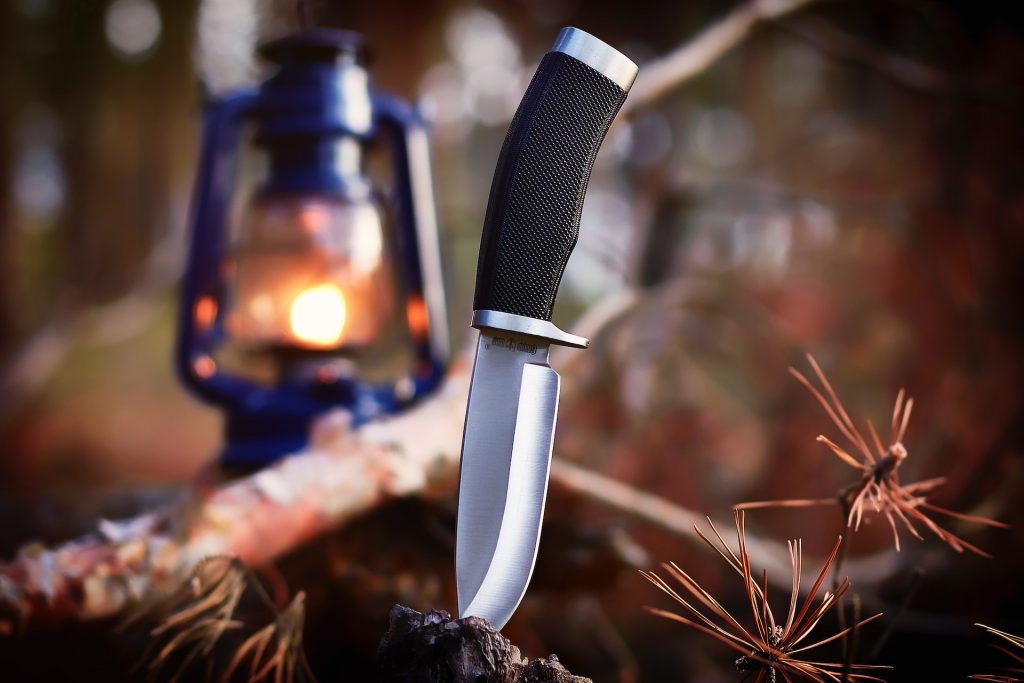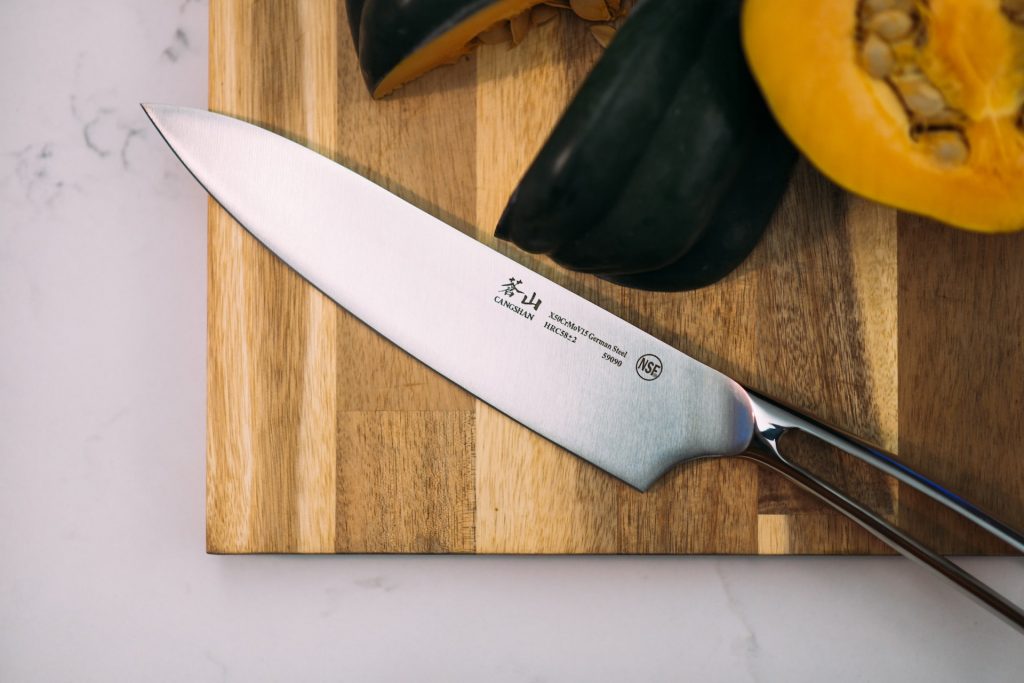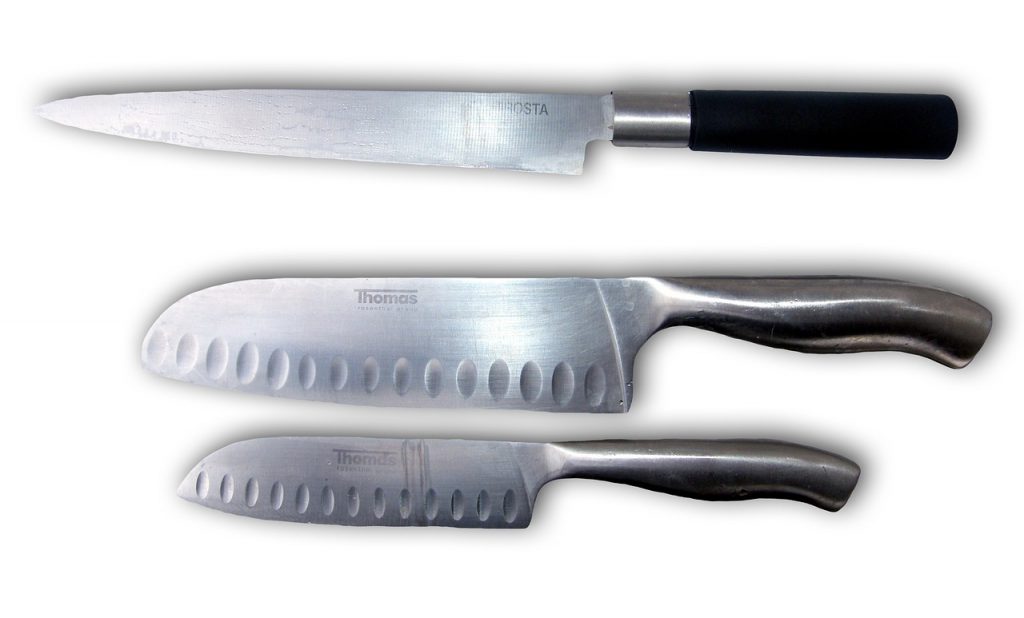Are you familiar with the term “tang on a knife”? Heard it thrown around in your kitchen or perhaps seen knives described as having different tangs? But do you know what is a tang on a knife why it is so important? Whether you are a professional or an amateur, understanding a knife’s tang can help you make more informed decisions when purchasing new knives.
In this blog post, we will discuss what a tang is, including how to identify the different types of tanged knives and their unique purposes.
What is a Tang on a Knife?

A knife tang refers to the portion of the blade that extends into the handle. It can be visible from the outside or hidden inside the handle itself. Depending on its design, it may contain several rivets or pins that hold it in place. Its purpose is to provide strength and stability when cutting or chopping with the blade.
Tangs are essential components in any knife because they help keep the blade firmly attached to its handle during use. Without a strong connection between these two pieces, there’s no telling when or how your knife might come apart during use—which could be dangerous!
Additionally, specific blades require longer or sturdier connections than others; for example, larger hunting or combat blades need considerable strength to remain intact during extended use.
The shape and size of the tang will vary depending on its intended use. For instance, if you are looking for a chef’s knife, you will want one with a full-length tang for added balance and control during use.
Why Does It Matter?
The quality of your knife’s tang matters because it affects its performance and longevity. A high-quality, full-length tang will provide more stability while using your knife than one with a partial or hidden tang. It means you will get more precise cuts with less effort, as there will be less movement between the blade and handle when used.
Additionally, knives with poor quality or short-tang designs are more prone to cracking or breaking due to their lack of stability under pressure.
Full Tang vs. Partial Tang

🔪Full Tang Knives
A full tang knife is a piece of metal that extends from the blade into the handle. It makes a full tang knife incredibly strong, stable, and durable. It also reduces wear over time as fewer weak points could cause it to break easily. And if you need to use a heavy-duty knife for tougher tasks such as chopping wood or cutting through thick rope, then a full tang knife is your best bet.
However, full-tang knives can be quite heavy due to their construction and size. They’re also more expensive because they require more material to make them stronger and more durable than other knives. Additionally, depending on its size and shape, a full tang knife may not be as comfortable in your hand as other types of knives due to its weight balance being off-center.
Some manufacturers add a metal plate to the back of a full tang knife to create a pommel. It makes it easier for you to hold the knife and provides an additional counterbalance. It’s also possible to taper the tang toward the butt to reduce the weight. This type of knife is best for tougher cuts but can be challenging to control. It’s not recommended for everyday use, though.
🔪Partial Tang Knives
Partial tang knives are lighter than full tang ones because they don’t have metal extending through the handle. Instead, only part of the metal extends into the handle, making these types of knives much lighter than their full-tang counterparts while providing adequate strength and stability for everyday tasks like cutting vegetables or slicing meat at home.
Partial-tang blades are also less expensive because they require less material to produce than a full-tang blade does. Regarding comfort, partial tangs tend to be more balanced in your hand since they don’t have extra weight pulling them off center as their heavier counterparts do.
To make a partial tang knife, you need to drill a hole for the tang. The process is similar to drilling with a regular knife, but you need to be careful not to drill too far or create a too small hole. In addition to the hole, you will need a drill-center tool in your drill press.
You will also need a wood block that fits the tang. Also, you will need to mark the center of the tang on the block. Use a tang hole saw to shape the hole. You will also need a pair of vise grips to clamp the spacer card together. You can also use metal material to make the card. The card should be about 1 1/4 inches wide and 1 3/8 inches tall. You should also rough it up with 120 grit paper.
Another method to rabbet a tang is to split the grip in half lengthwise. You will need to use a mortising pocket, and you will also need to use epoxy to secure the tang to the handle.
What are The Different Types of Knife Tangs?

Now that you know the difference between a full tang and a partial tang, what are the other types of knife tangs? It’s essential to understand the different types of knife tangs available and what each one means.
📌Encapsulated Tang
An enclosed tang is molded into the handle material instead of being pushed in. The handle fits well with the tang. The method’s strength is its significant benefit. Encapsulated tangs are more powerful and provide finer control than push tangs, which have a chance to break where the tang meets the handle.
It is a constrained method of tang construction. Hence, it is incompatible with all kinds of handle materials.
📌Skeletonized Tang
Skeletonized tangs are similar to partial tangs in that they do not extend completely through the handle. Instead, they feature cutouts along their length to reduce weight even further while providing enough strength for most applications. This type of tang is often found on tactical folding knives or neck knives since they need to be lightweight yet durable enough for use in tough conditions.
Large tang sections are cut away during the manufacturing process to reduce weight. A knife maker uses this technique to keep the overall mass of the knife as low as possible while maintaining strength. These cuts create additional stress points that could undermine the structural strength of the knife. To avoid these problems, manufacturers can increase the strength of a skeletonized knife by using thick and strong materials. In addition, the proper design can increase the strength of a knife.
Some skeletonized tangs have holes in the handle, which allow a finger to thread through for safety. In addition, these knives are often made without fittings, and you can easily clean them in highly corrosive environments. You can also sterilize these knives in an autoclave for disinfection.
📌Hidden Tang
A hidden tang is a type of full tang that hides within the handle. Hidden tangs are common in folding knives or kitchen cutlery. This tang type does not extend past the handle but is embedded inside it, with only a small portion visible at one end. While hidden tangs provide less strength than full tangs, they offer convenience since they fold up compactly when not in use.
Using a hidden tang on a knife can be a helpful way to save weight and increase handling flexibility. However, hidden tangs can also be a bit trickier to make.
There are two types of hidden tangs, the rat tail and the full-length tang. Both have a tang that extends through the handle. However, the rat-tail tang goes to the end of the handle.
It’s not uncommon for hidden tang blades to be enclosed in a solid handle, although this isn’t always practical. You can also use a bolster to balance your knife and to keep your hands from touching the blade.
📌Extended Tang
It is a full tang that extends beyond the knife’s handle. The tang can be straight or curved, depending on its usage. Extended tangs are often found on survival knives since they provide extra stability and leverage during use.
The extended tang also offers an additional surface for gripping and can be used as a hammer or for other purposes. This tang type is also sometimes found on chef’s knives, butcher knives, and other kitchen cutlery.
The extended tang does have its drawbacks – it adds extra weight to the knife and can make it more difficult to carry. However, an extended tang can make a knife more valuable and powerful for specific applications.
📌Rat-tailed Tang
The rat tail tang differs from both full and half-tang designs in that it consists of an extended metal rod that tapers at one end into a thin point (hence its name). This type of design is typically found on folding pocketknives since its narrow profile allows for easier storage when not in use while still providing adequate strength when opened up during use. As with half-tang designs, you should only use this type for light tasks since it offers less strength than full-tang designs.
A rat-tail tang is often associated with inexpensive knives. However, they are also common in bushcraft knives. They have a reputation for being difficult to weld and can snap at the end of the handle. Although they are beneficial for heavy use, they are not considered unsafe. Rat-tail tangs have been associated with cost-cutting methods in the west in the 20th century, but a full tang handle is now a staple in the west.
📌Push Tang
The Push Tang is a type of non-traditional tang that has unique characteristics. Manufacturers create this tang using a thin piece of material, such as brass or aluminum, which is then attached to the blade using an adhesive. The handle material is then pressed firmly onto the tang and fastened securely with small rivets to ensure it will stay in place.
The Push Tang offers a few advantages over traditional tangs. It is lightweight and provides more balance when you hold the knife. However, it does not provide as much strength and durability as other types of tangs, so you should only use it for lighter tasks. Additionally, because the handle material is pressed onto the tang, it can be more challenging to repair if damaged.
📌Tapered Tang
The Tapered Tang is a tang that tapers from the base to the end, making it strong and durable. This design is often used in heavy-duty, survival, or combat knives since it provides optimum strength and stability when cutting through tough materials. Additionally, because it tapers towards the end, it is less likely to snag on objects or clothing.
The Tapered Tang is an excellent choice for those looking for a strong and reliable knife. However, you should remember that this tang type can make a knife heavier or unbalanced if not designed properly. It can also be more challenging to work with when making repairs or replacing parts since it does not have a traditional full tang design.
How To Identify Your Knife’s Tang?

There are many different types of knives, and each type has unique features. One such feature is the tang, an essential component of a knife’s construction that can help you determine the quality of your knife. So how do you identify a knife’s tang?
Identifying the type of tang on your knife is relatively easy. When looking for your knife’s tang, start by examining where the blade meets with the handle or scales (the material covering either side of a full or partial tang). If you don’t see any metal extending through to either side, it may be one type of hidden tang or another type like skeletonized or rat tail where it’s visible but looks very small compared with other styles like full or short-tanged blades.
From there, you can determine if your knife has other features such as bolsters (metal plates between blade & handle) which indicate whether it’s likely a full or partial style, as well as pins & rivets used to secure them together. It can help you to narrow down what type of tang your knife has, such as a push or tapered.
Knowing what kind of tang is on your knife will give you a better understanding of the quality and ability of the blade. It also gives you an idea of what tasks and activities to best use the knife. Knowing what type of tang is vital to ensure you are using the right knife for your needs.
Which Knife Tang is the Most Ideal?

Some people argue that a half-tang knife is more suitable for complex jobs. Those who want to cut tender herbs without getting tired are probably better off with a half-tang knife. Partial tangs are often cheaper than full tangs but have a shorter lifespan.
Whether you’re looking for a knife for a serious outdoor activity or a survival adventure, a full-tang knife is a good choice. These knives offer excellent strength, balance, and stability. The blade is usually a heavy-duty material, which helps it stay sharp longer.
A full-tang knife is more expensive than a half-tang knife but is also more durable. In addition, a full tang blade is less likely to break during batoning. It is because the extra weight on the handle can offset the weight of the blade. It’s also easier to carry, making it easier to wield.
Full tang knives are also heavier than other types of knives. It means they can handle more heavy-duty tasks, but it also means they require more care when cleaning. You must be careful not to expose the edges of the blade, as the metal may rust. It’s essential to clean your knife before use because corrosion can make the knife unusable.
If you’re buying a full tang knife, check the description carefully to avoid buying a knife that’s inappropriate for your needs. The tang will also affect the performance of your knife, so it’s essential to look for a knife with a sturdy blade.
Frequently Asked Questions
What are some common problems with knife tangs?
Some common problems with knife tangs include corrosion, wear, and tear, weakness of the blade due to a lack of full tang construction, and difficulty replacing or repairing parts due to the lack of a traditional full tang design.
How does a knife tang affect the knife’s price?
The type of tang on a knife can influence the price. Generally, full tang knives are more expensive than partial or hidden tang knives since they offer more stability and strength. They can also be heavier and require more care when cleaning and maintaining. In contrast, partial or hidden tang knives may be lighter and less expensive, but they usually don’t offer the same stability and durability.
Are full-tang knives better?
Full tang knives typically offer the best stability, strength, and durability of all types of knives. They are heavier than other knives, but they are perfect for heavy-duty tasks requiring more strength and support. They also require more care when cleaning, as corrosion can easily occur if you regularly perform proper maintenance.
How long should a tang be on a knife?
The length of a tang on a knife will vary depending on the type and design of the knife. Generally, full tangs are usually longer than partial tangs, while hidden or skeletonized tangs may be even shorter. For most kitchen knives, a full tang should measure at least 4-5 inches in length for optimal stability and strength. Top brands typically establish at least two-thirds of the length of the handle as tang.
What is the rarest tang?
The rarest tang is probably the full-integral tang formed through a single piece of metal. This type of knife does not have any welded points or rivets to secure the handle, and it features an extended guard between the blade and handle for added stability. However, these knives are very expensive and difficult to come by.
Final Words
When choosing a knife, it is essential to consider what type of tang the blade has. A tang is the portion of the blade that extends into the handle, which can affect the knife’s performance and price. Identifying your knife’s tang is essential when determining its quality and performance capabilities. A good quality knife should have a strong and durable tang that extends through its handle for maximum strength and stability.
By understanding what kind of blade construction your knife has and its specific type, you’ll better understand what use cases best fit your knife’s purpose, whether carving wood at campfires or slicing onions at home!
